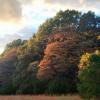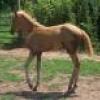What color/pattern appy on this filly?
Forums
Re: What color/pattern appy on this filly?
Why cannot that just be a frosted blanket, ie Frosting (or varnish if you like) inhibited by the blanket pattern???
I had a mare who had this pattern a few years back, she did change a tiny, tiny bit, but not as much as a "normal" Frosted would.
I described her as a Frosted Blanket and, you know what, the lady that bought her (who was lovely but a wee bit ditsy) actually understood what I meant, on the phone, and she would not have been able to tell a Leopard from a Lamp post in a good light!!!
Re: What color/pattern appy on this filly?
[quote="GiddyUp"] I am now curious what a false leopard or few spot is since it was brought up.[/quote]I think near leopard is more common than a false leopard, as peoples definitions are a bit different with that in my.
So to ME:
A false few spot is a horse who is not truly homozygous for LP, but has varnished out to nearly pure white and only has a few spots.
A false leopard to me is a horse who started out with a blanket, rather than a full leopard pattern but has varnished out to have spots all over and look like a leopard.
A near leopard to me is a horse who almost has a full leopard pattern, but not quite. For example, this is a near leopard to me
[img]http://www.jgappaloosas.com/foals2009/p…]
[img]http://www.jgappaloosas.com/foals2008/c…]
Re: What color/pattern appy on this filly?
[quote="GiddyUp"][quote="admin"]Varnish roan is an appaloosa pattern and is different from classic roan. It thought to be caused by LP that is present without a PATN gene. So she would have inherited it from her sire.[/quote]
So I am to understand that a varnish roan does NOT have to come from a varnish roan like a classic true roan. WOW...so much to learn!!! [/quote]
Right, unlike classic roan (or sabino/rabicano roaning), varnish roan is not just an admixture of coloured and white hairs. Varnish roan "removes" the colour, but leaves spots if the 'command' for spots is there--hence a blanke with spots horse "turning" into a leopard if it 'roans out'. However, varnish roan will leave colour smudges in bony areas, i.e., hip points, cheeks, bridge of nose, etc..
[quote="GiddyUp"]
Ok so the clear defined white hair around her eyes and the white roaning on her head, even though not as much as her body, does that mean she will most likely roan all the way to white or almost all white? Can someone explain to me a "false leopard or few spot" please?[/quote]
Could do, our old stallion is a prime example. He was described as having a blanket on his registration papers from the ApHC, but roaned to 'solid' white by the time he arrived here in NZ, hence was thought to be a fewspot. And that, basically is one description for a false fewspot/leopard. Those are horses that had colour and a blanket pattern, and then roaned out leaving only spots or no spots. A false snowcap is a horse that has an all white bum, but is really getting a white boost from another gene, current culprit being thought to be sabino.
Diane
Re: What color/pattern appy on this filly?
Thanks NZ Appaloosas for explaining. I am still amazed that appy's are so different and there is such thing as a false leopard/few spot! Now this filly's sire, since he is the full white with spots as a baby, he is a true leopard, correct? So there are many "false" leopards out there because they are not born leopard however, am I correct then in thinking breeding appys, you can get pratically ANY pattern from any kind of appy or is there some sort of rules to this such as if you breed a leopard to a leopard you will get a leopard? I have not researched appys at all since I just got a couple of them but looks like I need too!
Re: What color/pattern appy on this filly?
Never heard of a False Leopard....to me a Near leopard is anything that is mostly spotted but has solid colour on head and legs and anything that is not born Leopard but ends up looking Leopard.
False Fewspot is anything that looks Fewspot but isn't, or cannot be, and ditto Snowcap and False Snowcap.
Re: What color/pattern appy on this filly?
A false leopard is anything that wasn't born nose-to-toes leopard...a horse can't "grow up" to be a leopard pattern. Any horse that develops a leopard pattern as it gets older and roans out, is not a leopard, it's a blanket with roaning.
As far as pattern-size and inheritance, true fewspots do only seem to come from leopard patterning, at least on one side if not both. Other than that, I would say all bets are off :laugh1
For example, Casey came from Wap Spotted x a "solid" mare...he's got more white at birth than either parent.
Princess, again a Wap Spotted, this time x with a 'near fewspot'/extensive blanket mare, has a decent-sized blanket, but it doesn't go past her withers. (dam basically has coloured head, a tad of smudging on neck, armpits, that sort of colour). Note, however, her dam does have a different pattern "under" her white, when you get to skin level, for whatever that may be worth. Everyone else tells me that the mare has not changed pattern since the day she was born.
Bubba, again Wap Spotted x true-nose-to-toes leopard, is a bluddy solid...his cousin, Newboy (dams are half sisters) has a blanket pretty much to withers and a lot more , out of a snowflake dam by a blanket/roaned to mostly white stallion.
Diane
Re: What color/pattern appy on this filly?
What you are calling "false" we call "near", so a "Near Leopard is anything that looks Leopard but was not so at birth.
A "True Leopard" is one that is born fully spotted in it's as adult patterned coat.
I have a feeling the Blanket pattern, the Leopard pattern and the Varnish/Frosting /whatever we decided to call it, pattern are all going to turn out to be separate patterns in the way that Tobiano is separate from Splash...and then calling an extended Snowcap a "near fewspot" is probably going to seem a little silly ;)
Why not call it an extended Snowcap as we used to, until (if this ever happens) we actually get some proof either way.
On which note, Diane do you not find it strange, with all the genes that are being isolated all over the place, that the Appaloosa Project has not isolated one yet, nor come up with any sort of test?
Re: What color/pattern appy on this filly?
[quote="rabbitsfizz"]What you are calling "false" we call "near", so a "Near Leopard is anything that looks Leopard but was not so at birth. [/quote]
Ahh, okay. So what do you call a foal that is spotted on body and up thru' the neck (solid head, maybe some solid on the neck), but not completely nose-to-toes?
[quote="rabbitsfizz"]
A "True Leopard" is one that is born fully spotted in it's as adult patterned coat. [/quote]
Agreed
[quote="rabbitsfizz"]
I have a feeling the Blanket pattern, the Leopard pattern and the Varnish/Frosting /whatever we decided to call it, pattern are all going to turn out to be separate patterns in the way that Tobiano is separate from Splash...and then calling an extended Snowcap a "near fewspot" is probably going to seem a little silly ;) [/quote]
This is where I get a tad confuzzled, when you talk like that, because tobiano, splash, and frame are caused by different genes (and I won't even start with sabino...), whereas the appaloosa patterning is dependent upon the presence of Lp. The theorised PATN gene(s) are what control the amount of expression.
Why not call it an extended Snowcap as we used to, until (if this ever happens) we actually get some proof either way.
[quote="rabbitsfizz"]
On which note, Diane do you not find it strange, with all the genes that are being isolated all over the place, that the Appaloosa Project has not isolated one yet, nor come up with any sort of test?[/quote]
yes and no...remember, the Appaloosa Project is dependent upon volunteers and donations, and as far as I'm aware, not given any grant money that would allow Rebecca to sit down and do nothing but search for the needed gene(s). One of the machines that would mike life a bit easier for Rebecca costs, second-hand, over US$80k... I wish the ApHC and the other world-wide appy clubs, as well as the knab registry would get on board and start helping them out, financially.
Diane
Re: What color/pattern appy on this filly?
I do not understand why they don't ....I begin to suspect they don't want to know the truth, and the Lp thing is still conjecture, too, isn't it??
So we do not actually [i]know[/i] any more than we did, oh, ten years ago??
[quote="NZ Appaloosas"]
Ahh, okay. So what do you call a foal that is spotted on body and up thru' the neck (solid head, maybe some solid on the neck), but not completely nose-to-toes? [/quote]
I have a colt like that at the moment, and I call him an extended blanket, BUT he does have spots on the dark bits too...his sire is a Snowcap Pintaloosa, so there are obviously multiple genes at work, but visually he is an extended blanket.
[quote="NZ Appaloosas"]This is where I get a tad confuzzled, when you talk like that, because tobiano, splash, and frame are caused by different genes (and I won't even start with sabino...), whereas the appaloosa patterning is dependent upon the presence of Lp. The theorised PATN gene(s) are what control the amount of expression.
Why not call it an extended Snowcap as we used to, until (if this ever happens) we actually get some proof either way.[/quote]
Yes, you are right, that was a poor analogy, a better one would be the Sabino complex, which we already know is polygenous, what I was trying to say was that the patterns are separate but appear to interact.
As far as I know a Leopard cannot cause a Blanket, the Blanket "gene" has to come form the sire or dam to be there, a straightforward Leopard does not sire Blankets.
A friend of mine, Liz Seymour of Wantsley Stud, sold us the brightest strongest "blanket" on Red base colt I had ever seen, but went to some lengths to impress upon us that he would not stay Blanket as there was no Blanket genetic involved in his bloodlines.
He had not a single white hair on his body until he was approaching three when he dropped his winter coat and was "marbled" all over his front end...looked really unusual....eventually he went white except of course he kept his blanket with spots on it and grew some tiny spots on his front end....I have often wondered though if Liz was right, as he retained spots on the blanket area, so to my way of thinking now, he actually would have had Blanket + probably a form of varnish????
Re: What color/pattern appy on this filly?
[quote="accphotography"][quote="rabbitsfizz"]
Yes, you are right, that was a poor analogy, a better one would be the Sabino complex, [b]which we already know is polygenous[/b], what I was trying to say was that the patterns are separate but appear to interact.[/quote]
We do????!!!! :?[/quote]
Ayup, otherwise SB-1 testing would work on more horses...
Diane
Re: What color/pattern appy on this filly?
[quote="rabbitsfizz"]I do not understand why they don't ....I begin to suspect they don't want to know the truth, and the Lp thing is still conjecture, too, isn't it?? [/quote]
Again, yes and no...Rebecca found which chromosome Lp exists on, but hasn't nailed down which allele, from what I understand.
[quote="rabbitsfizz"]
So we do not actually [i]know[/i] any more than we did, oh, ten years ago??[/quote]
Again, yes and no :laugh1
[quote="rabbitsfizz"]
[quote="NZ Appaloosas"]
Ahh, okay. So what do you call a foal that is spotted on body and up thru' the neck (solid head, maybe some solid on the neck), but not completely nose-to-toes? [/quote]
I have a colt like that at the moment, and I call him an extended blanket, BUT he does have spots on the dark bits too...his sire is a Snowcap Pintaloosa, so there are obviously multiple genes at work, but visually he is an extended blanket.[/quote]
Officially, as in dealing with the ApHC, he would be considered a blanket...but then again, ApHC also calls a nose-to-toes leopard a "roan"...so I'm not sure what value that has. :laugh1
The reason we use "near" is because a horse like this is nearly a leopard (or fewspot), but not quite. At least, the people I know who use the term, use it that way.
[quote="rabbitsfizz"]
[quote="NZ Appaloosas"]This is where I get a tad confuzzled, when you talk like that, because tobiano, splash, and frame are caused by different genes (and I won't even start with sabino...), whereas the appaloosa patterning is dependent upon the presence of Lp. The theorised PATN gene(s) are what control the amount of expression.
Why not call it an extended Snowcap as we used to, until (if this ever happens) we actually get some proof either way.[/quote]
Well, cuz basically, I've never run into anyone other than you who doesn't use these terms. So I'm thinking there's a regional/geographical basis behind the differences.
[quote="rabbitsfizz"]
Yes, you are right, that was a poor analogy, a better one would be the Sabino complex, which we already know is polygenous, what I was trying to say was that the patterns are separate but appear to interact.
As far as I know a Leopard cannot cause a Blanket, the Blanket "gene" has to come form the sire or dam to be there, a straightforward Leopard does not sire Blankets. [/quote]
Part of the problem there is presuming that breeders bred for specifi patterns, and that leopard to leopard was the norm, so should only have leopard patterning behind it...working on the assumption that the gene for leopard sized "blanket" is dominant, the blanket gene wouldn't express, but could be passed on to the foal, so therefore a blanket could come from leopard breeding. Since a lot of appy breeders do not breed just like pattern to like pattern, it is very hard to separate out where some sort of pattern might be coming from in a given bloodline.
[quote="rabbitsfizz"]
A friend of mine, Liz Seymour of Wantsley Stud, sold us the brightest strongest "blanket" on Red base colt I had ever seen, but went to some lengths to impress upon us that he would not stay Blanket as there was no Blanket genetic involved in his bloodlines.
He had not a single white hair on his body until he was approaching three when he dropped his winter coat and was "marbled" all over his front end...looked really unusual....eventually he went white except of course he kept his blanket with spots on it and grew some tiny spots on his front end....I have often wondered though if Liz was right, as he retained spots on the blanket area, so to my way of thinking now, he actually would have had Blanket + probably a form of varnish????[/quote][/quote]
snowflaking + varnish roan + blanket? Any possibility of grey there, since most frequently, that sort of patterning does seem to come about with grey working on the front end, then eventually, slowly erasing the blanket spots.
Diane
Re: What color/pattern appy on this filly?
[quote="NZ Appaloosas"][quote="accphotography"][quote="rabbitsfizz"]
Yes, you are right, that was a poor analogy, a better one would be the Sabino complex, [b]which we already know is polygenous[/b], what I was trying to say was that the patterns are separate but appear to interact.[/quote]
We do????!!!! :?[/quote]
Ayup, otherwise SB-1 testing would work on more horses...
Diane[/quote]
Ok... I'm not going to agree with that yet, but I'm going to give the benefit of the doubt until I have the answer to this question:
What is your definition of "polygenous"?
Re: What color/pattern appy on this filly?
Well, in connection with the "white", say in tobiano, appaloosa, etc., to me polygenous means that there is more than one gene involved with the levels of expression possible. In connection with "sabino", I think it is like dominant white, either multiple genes or multiple mutations causing similar phenotypes--I think we are going to find that "sabino" is as much a catch-phrase as "overo" is.
Diane
Re: What color/pattern appy on this filly?
Diane, thanks for all that, as usual your answers are not only understandable to a partially brain dead geriatric, but immensely patient as well....always appreciated.
Yes, ACC we [i]do[/i]know Sabino is polygenous, have suspected for many years and have known since Sab1 was isolated and Clydesdales did not have it.......
http://en.wiktionary.org/wiki/polygenous" onclick="window.open(this.href);return false;
I went and looked it up for you because I am pretty sure this is where I found it in the first place, I am prone (very much so) to inserting words that just[i] sound[/i] right into sentences, and am getting worse, so I am aware I can often get the wrong word, but I had so much trouble inserting this one into my memory bank (hammer worked in the end) that I am certain of it!! :sign
Re: What color/pattern appy on this filly?
[quote="rabbitsfizz"]Diane, thanks for all that, as usual your answers are not only understandable to a partially brain dead geriatric, but immensely patient as well....always appreciated.
[/quote]
The reason I left teaching wasn't because of the kids, it was because of the parents...that and teaching isn't really my gig, I have a lot more fun in the legal minefields. :laugh1 :laugh1 but you're welcome, and don't ever hesitate to ask and re-ask, if needed. As my husband says, I do sometimes start in the middle of the conversation (or sentence) rather than at the beginning.
Diane
Re: What color/pattern appy on this filly?
[quote="accphotography"]Ok I've just spent a little time looking at definitions of polygenous, and I was wrong. I now side with both of you about sabino and LP. I just misunderstood what "polygenous" meant.[/quote]
Out of curiosity, what did you think it meant? I did have "polygenous" drummed into me in my high school genetics class, but then, unlike most people, I was blessed in having a geneticist for a teacher...she had given up doing her research in the US to accompany her husband back to the homeland, and took up teaching as a way to fill her day.
Diane
Re: What color/pattern appy on this filly?
That's good then. I know I had a hard time wrapping my brain around people saying their black horses "carried the red gene", because to me agouti was "the red gene" since it made black horses show red bodies. And while I was fully cognizant that a heterozygous black could produce a "red" foal, it just never equated into that being "the red gene". :laugh1
Diane
Re: What color/pattern appy on this filly?
[quote]I know I had a hard time wrapping my brain around people saying their black horses "carried the red gene"[/quote]
Hehe I think we've all had things that like. When I was first learning about colors I was confused when someone said their black horse was homozygous for black. I kept thinking that because all black horses are aa they all to be homozygous for black since aa was homozygous and caused the horse to be black.
Re: What color/pattern appy on this filly?
Well guys, I won't tell you what "I thought" homozgous and heterozyous meant... :oops: :BH :laugh1 Did I mention that I actually flunked Biology? (well almost, I got a D) In my defence, most of that was due to my missing classes because of disection animals preserved in formaldehyde - I'm allergic and would pass out at the opening of the first jar.








Re: What color/pattern appy on this filly?
[quote="admin"]Varnish roan is an appaloosa pattern and is different from classic roan. It thought to be caused by LP that is present without a PATN gene. So she would have inherited it from her sire.[/quote]
So I am to understand that a varnish roan does NOT have to come from a varnish roan like a classic true roan. WOW...so much to learn!!!
Ok so the clear defined white hair around her eyes and the white roaning on her head, even though not as much as her body, does that mean she will most likely roan all the way to white or almost all white? Can someone explain to me a "false leopard or few spot" please?